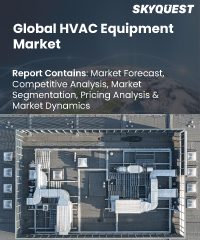
Product ID: SQMIG20D2141

Report ID:
SQMIG20D2141 |
Region:
Global |
Published Date: March, 2024
Pages:
202
|
Tables:
95 |
Figures:
76
Global HVAC Equipment Market size was valued at USD 138.32 billion in 2022 and is poised to grow from USD 147.17 billion in 2023 to USD 241.75 billion by 2031, growing at a CAGR of 6.40% during the forecast period (2024-2031).
Global HVAC Equipment Market is a thriving and essential sector that caters to the heating, ventilation, and air conditioning needs of various industries and residential spaces. The increasing construction activities, particularly in emerging economies, drive the demand for HVAC systems in new residential and commercial buildings. The growing awareness of energy-efficient solutions and the need to reduce carbon emissions propel the adoption of energy-efficient HVAC equipment. Additionally, factors such as urbanization, changing climatic conditions, and improving living standards contribute to the market expansion.
Factors such as high installation and maintenance costs, particularly for advanced systems, can hinder market growth. The complex regulatory landscape and varying energy efficiency standards across different regions also pose challenges for manufacturers and consumers alike. Furthermore, the COVID-19 pandemic has temporarily impacted the market due to disruptions in supply chains and construction activities. Key trends in the HVAC equipment market include the integration of smart technologies and the Internet of Things (IoT) for enhanced automation, energy management, and remote monitoring. The market is witnessing a shift towards sustainable refrigerants and eco-friendly solutions to mitigate the environmental impact of HVAC systems. Moreover, there is a growing focus on improving indoor air quality through advanced filtration systems and air purifiers, driven by concerns over respiratory health and allergies. Amidst these challenges and trends, several opportunities exist in the HVAC equipment market. The increasing demand for retrofitting existing HVAC systems with energy-efficient and smart solutions presents a significant market opportunity. The rapid expansion of the construction industry, particularly in developing countries, offers immense potential for HVAC equipment manufacturers. Additionally, the rising demand for green buildings and sustainable infrastructure drives the need for eco-friendly HVAC solutions.
US HVAC Equipment Market is poised to grow at sustainable CAGR for the next forecast year.
Our industry expert will work with you to provide you with customized data in a short amount of time.
REQUEST FREE CUSTOMIZATIONWant to customize this report? This report can be personalized according to your needs. Our analysts and industry experts will work directly with you to understand your requirements and provide you with customized data in a short amount of time. We offer $1000 worth of FREE customization at the time of purchase.

Product ID: SQMIG20D2141